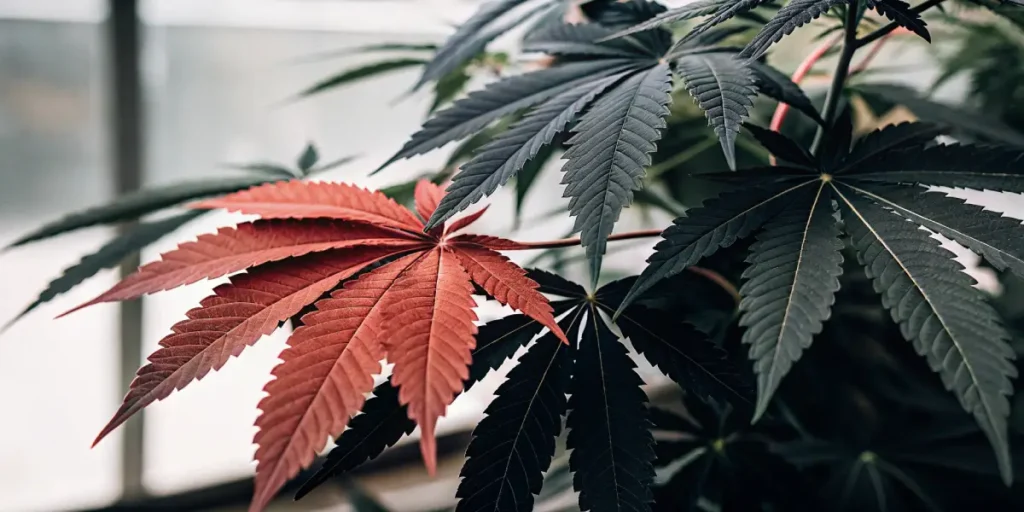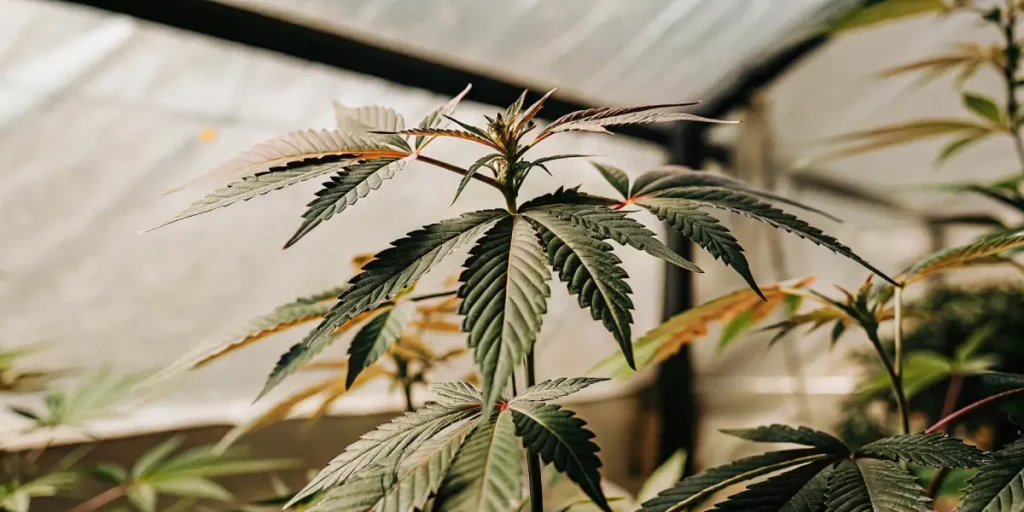Phosphorus deficiency in cannabis can become a serious issue if not addressed promptly. It often manifests as darkening leaves with a purplish tint, and in severe cases, the leaves may turn brown and crispy. This nutrient deficiency can stunt plant growth, reduce yields, and affect overall plant health.
To tackle phosphorus deficiency cannabis problems, it’s crucial to understand what phosphorus does in the plant. Phosphorus plays a vital role in energy transfer within the plant, aiding in photosynthesis and nutrient movement. When there is a lack, plants struggle to develop roots and flowers, which can be a nightmare for growers.
Growers often notice these issues during the flowering stage when phosphorus demands are high. The key is to spot the symptoms early and act swiftly. Let’s delve into the causes, symptoms, and solutions to effectively handle phosphorus deficiency in cannabis plants.
Identifying Cannabis Phosphorus Deficiency Symptoms
Recognizing cannabis phosphorus deficiency symptoms early can save your crop. The first signs often appear on older leaves. You might see a bluish-green hue, which later shifts to a reddish-purple. As the deficiency progresses, leaves may curl or develop brown spots.
These symptoms can easily be confused with other nutrient deficiencies or environmental stressors. However, the distinct purplish coloration is a tell-tale sign of phosphorus issues. Monitoring your plants regularly, especially during the flowering phase, can help catch these symptoms before they become severe.
In addition to discoloration, phosphorus deficiency cannabis plants may exhibit stunted growth and reduced vigor. The lack of phosphorus affects the plant’s ability to produce energy efficiently, which in turn impacts its overall health and development. Growers should also look for signs of weak root systems and poor flower formation, particularly during critical growth stages.
It’s essential to differentiate between phosphorus deficiency and other potential nutrient issues, such as nitrogen or potassium deficiencies, to apply the correct treatment. Conducting a thorough inspection of the growing environment and soil conditions will provide insights into the underlying cause, allowing for a more targeted approach to phosphorus deficiency cannabis nutrient management.
Common Causes of Phosphorus Deficiency in Cannabis
Several factors can lead to phosphorus deficiency cannabis problems. One common cause is low soil pH. Cannabis plants prefer slightly acidic soil, and if the pH falls below 6.2, phosphorus becomes less available to the plant. Regular pH checks can help prevent this issue.
Cold weather can also exacerbate phosphorus deficiency. Cannabis plants are sensitive to temperature changes, and cooler climates can slow down phosphorus uptake. Ensure your growing environment maintains a consistent temperature to support healthy nutrient absorption.
In addition to pH and temperature, overwatering or underwatering can significantly impact phosphorus availability. Excess water can wash away nutrients, including phosphorus, while insufficient water can hinder nutrient uptake by the roots. Implementing a balanced watering schedule is crucial for maintaining optimal nutrient levels and avoiding phosphorus deficiency cannabis.
Another underlying cause is the quality and composition of the growing medium. Poorly formulated soils or hydroponic solutions lacking in essential nutrients can lead to deficiencies. Incorporating organic matter and ensuring a well-aerated soil structure can enhance phosphorus availability and prevent phosphorus deficiency in cannabis plants solutions.
Preventing Phosphorus Deficiency in Cannabis
Preventing phosphorus deficiency in cannabis involves proactive nutrient management. Start by testing your soil or growing medium. This helps identify any deficiencies early. Adjust the pH to ensure it stays within the ideal range for cannabis growth.
Consider using fertilizers that are rich in phosphorus, especially during the flowering stage. Products formulated for blooming plants often contain higher phosphorus levels, supporting robust flower development. Keep an eye on your plants’ nutrient needs as they grow and adjust accordingly.
Incorporating organic fertilizers like bone meal or rock phosphate can provide a slow-release source of phosphorus, ensuring consistent availability throughout the plant’s growth cycle. Regular soil amendments with these organic options can significantly reduce the risk of phosphorus deficiency cannabis issues.
Aside from nutrient management, environmental control is pivotal in preventing phosphorus deficiency. Ensure that temperature and humidity levels are optimal for cannabis growth, as these factors influence nutrient uptake. A stable growing environment not only supports phosphorus absorption but also enhances overall plant resilience against various stressors.
Fixing Phosphorus Deficiency in Marijuana
Fixing phosphorus deficiency in marijuana requires prompt action. First, verify the soil pH. Adjust it if necessary, using lime or sulfur, to bring it back to the optimal range. This will help the plant absorb phosphorus more efficiently.
Next, consider your feeding schedule. Increase phosphorus levels with a suitable fertilizer. Liquid fertilizers can be more effective as they are rapidly absorbed by the plant. Follow the instructions carefully to avoid nutrient burn.
Besides to adjusting pH and nutrient levels, implementing a foliar feeding regimen can provide an immediate boost of phosphorus directly to the leaves. This method allows for quick absorption and can be particularly beneficial for fixing phosphorus deficiency in marijuana when root uptake is compromised.
Regular monitoring and adjustments to the growing conditions are essential following any corrective measures. Observing changes in leaf color and plant vigor can provide insights into the effectiveness of the interventions, aiding in further phosphorus deficiency cannabis nutrient management efforts.

Step-by-Step Solutions for Phosphorus Deficiency Cannabis Nutrient Management
Begin by flushing your plants with pH-balanced water. This helps remove any nutrient lockout caused by salt buildup. Once the soil is flushed, apply a phosphorus-rich fertilizer. Ensure you choose a product that matches your growing medium, whether soil or hydroponic.
Monitor your plants closely after applying the solution. Look for signs of recovery, such as new growth without discoloration. It might take a week or two to see noticeable improvements, so patience is key.
Continual assessment of the growing environment is vital for preventing recurrence. Adjust lighting, temperature, and humidity to suit the specific needs of your cannabis strain, as these factors can influence phosphorus uptake. A holistic approach to environmental management supports overall plant health and mitigates phosphorus deficiency cannabis risks.
Furthermore, keeping a detailed log of nutrient feedings and plant responses can help identify patterns or recurring issues. This record-keeping enables growers to fine-tune their strategies and optimize phosphorus deficiency cannabis nutrient management techniques over time.
- Test soil and adjust pH levels regularly.
- Use phosphorus-rich fertilizers during flowering.
- Maintain consistent growing temperatures.
- Choose resilient strains like Blue Dream, Northern Lights, and OG Kush.
- Monitor plants for early symptoms and act swiftly.
FAQs: Phosphorus Deficiency in Cannabis
What are the early signs of phosphorus deficiency in cannabis?
Early signs of phosphorus deficiency in cannabis include a change in leaf color. You might notice older leaves taking on a bluish-green or purplish hue. This happens because phosphorus is mobile within the plant, and it moves to newer growth when in short supply. As the deficiency progresses, affected leaves can develop brown spots and may curl or dry out.
Regularly inspecting your plants is crucial to catching these signs early. If you see these symptoms, check the pH and nutrient levels immediately. Quick intervention can prevent further damage and help your plant recover faster. Consider strains like Northern Lights from Global Green Genetics, which are known for their resilience against nutrient deficiencies.
In addition to visual cues, a phosphorus deficiency can affect the plant’s growth rate and flowering potential. Plants may exhibit sluggish growth or fail to produce abundant buds, leading to lower yields. Timely identification and correction are essential to minimizing the impact of phosphorus deficiency cannabis on overall plant health.
Implementing a regular inspection routine and maintaining a detailed grow journal can aid in early detection and intervention. Tracking changes in leaf color, growth patterns, and environmental conditions provides valuable insights for effective phosphorus deficiency cannabis nutrient management.
How can I prevent phosphorus deficiency in cannabis plants?
Preventing phosphorus deficiency involves maintaining proper soil conditions. Regularly test the soil pH and keep it between 6.2 and 7.0. This range ensures optimal phosphorus availability. Additionally, use a balanced nutrient solution tailored for cannabis, which includes adequate phosphorus levels, especially during the flowering stage.
Selecting robust cannabis strains can also help. Strains like OG Kush are less susceptible to nutrient issues and can thrive even in suboptimal conditions. Always ensure your growing environment, including temperature and humidity, is consistent and conducive to healthy plant growth.
Implementing a preventative maintenance strategy that includes regular soil testing and nutrient adjustments can significantly reduce the risk of phosphorus deficiency cannabis issues. By proactively managing these factors, growers can ensure their plants receive the necessary nutrients throughout the growth cycle.
Furthermore, integrating diverse organic materials into the soil, such as compost or manure, can enhance nutrient availability and promote a healthy microbial ecosystem beneficial for nutrient uptake. This holistic approach supports long-term plant health and prevents phosphorus deficiency in cannabis plants solutions.
What solutions are available for fixing phosphorus deficiency in marijuana?
Fixing phosphorus deficiency involves a few straightforward steps. Start with a simple pH test of your growing medium. Adjust the pH to the ideal range if needed. Once the pH is corrected, apply a phosphorus-rich fertilizer. Opt for formulations specifically designed for cannabis flowering stages, as these will have the right nutrient balance.
After applying the correction, monitor your plants closely. Look for new growth that shows no signs of deficiency. It may take several days to a couple of weeks for full recovery. Ensure your nutrient schedule is consistent and make adjustments as your plants grow to prevent recurrence.
Incorporating foliar feeding cannabis as an emergency measure can rapidly address phosphorus deficiency cannabis issues by providing nutrients directly to the leaves. This technique is especially effective when root uptake is compromised due to environmental factors or root damage.
Post-correction, implementing a regular assessment routine for soil and environmental parameters can prevent future deficiencies. Adjusting the nutrient regimen based on plant developmental stages and environmental conditions ensures sustained phosphorus deficiency cannabis nutrient management success.
Can environmental factors contribute to phosphorus deficiency?
Yes, environmental conditions can significantly impact nutrient uptake, including phosphorus. Cool temperatures can slow down the plant’s metabolism, reducing phosphorus absorption. A consistent temperature that mimics the plant’s natural environment can help mitigate this issue.
Other factors such as poor soil quality or incorrect watering practices can also lead to phosphorus deficiency. Ensure your growing medium is of high quality, and your watering technique supports healthy root development. By managing these factors, you can help prevent phosphorus deficiency in cannabis.
Light intensity and duration also play a critical role in nutrient uptake. Insufficient light can limit photosynthesis, impacting phosphorus uptake and utilization. Ensure your cannabis plants receive adequate light for their growth stage to support optimal nutrient absorption and prevent phosphorus deficiency cannabis.
Additionally, maintaining proper airflow and ventilation within the growing space helps regulate temperature and humidity levels, creating an environment conducive to healthy plant growth. These adjustments in environmental management are key to preventing phosphorus deficiency in cannabis solutions.
Are certain cannabis strains more resistant to phosphorus deficiency?
Indeed, some cannabis strains are more resilient to nutrient deficiencies. Strains such as Blue Dream and OG Kush are popular among growers for their hardiness and ability to thrive even with minor nutrient imbalances. These strains can be ideal for beginners or those looking to minimize the risk of phosphorus issues.
Choosing the right strain can make a significant difference in your growing experience. Consider factors like your climate, growing setup, and experience level when selecting seeds. Global Green Genetics offers a variety of strains, allowing you to pick one that best suits your growing conditions and reduces the likelihood of phosphorus deficiency.
In addition to resilience, selecting strains that naturally adapt to your local climate and soil conditions enhances their ability to withstand nutrient deficiencies. Research and trial different strains to determine which perform best in your specific growing environment, minimizing phosphorus deficiency cannabis concerns.
Furthermore, collaborating with local growers and utilizing resources such as forums and grower communities can provide insights into strain performance and phosphorus deficiency cannabis nutrient management. Leveraging shared knowledge helps in making informed decisions regarding strain selection and cultivation techniques.

